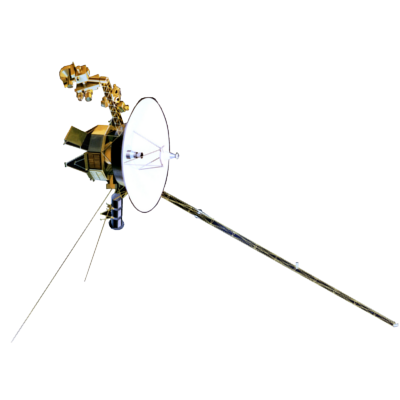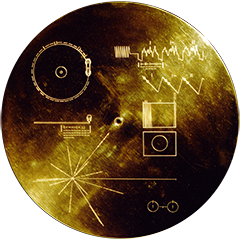Voyager LECP Data Analysis Handbook
Data File Descriptions
Experiment Data Record (EDR) Format Specification
APPENDIX B: Engineering Experiment Data Record Formation
The Engineering Record will be used in the engineering EDR and all normal-rate Science EDR's. The Engineering Record Format is described in Figure B-2, the Standard Record Header in Appendix C , and the Engineering Data Block in Figure B-4 and Table B-1. This Engineering data block contains engineering data for 60 EMF for both 10 and 40 bps data. Each channel will appear in the same location during a readout sequence. For 40 and 10 bps data, a readout sequence is accomplished in 12 and 48 minutes respectively. Decommutation must be done with the last Decom Map preceeding the Engineering record.
Figure B-2. Engineering Record (965 32-bit words)
| Standard Header (60) |
Subhdr Spares (5) |
Engr MF 1 (15) |
Engr MF 2 (15) |
Eng MF 3 (15) |
Eng MF 4 (15) |
Eng MF 5 (15). . |
Eng MF 59 . . (15) |
Eng |
Figure B-4. Engineering Record Data Block Format
| EDR Data Word |
Bits 31 24 |
16 |
8 |
0 |
31 24 |
16 |
8 |
0 |
| 1 | COM Position 100 |
COM Position 101 |
COM Position 102 |
COM Position 103 |
COM Position 104 |
COM Position 105 |
COM Position 106 |
COM Position 107 |
| 3 | COM Position 108 |
COM Position 109 |
COM Position 110 |
COM Position 111 |
COM Position 112 |
COM Position 113 |
COM Position 114 |
COM Position 115 |
|
: |
. . . |
|||||||
| 13 | COM Position 148 |
COM Position 149 |
COM Position 150 |
COM Position 151 |
COM Position 152 |
COM Position 153 |
COM Position 154 |
COM Position 155 |
| 15 | COM Position 156 |
COM Position 157 |
COM Position 158 |
COM Position 159 |
||||
The Engineering EDR will contain Engineering Records, Imaging Status Records, Monitor Records, and Decommutation Map Records. The Decom Record is described in Appendix A. The Engineering record formats are shown in Figure B-2. Each of these records utilizes the Standard Record Header described in Appendix C, with some re-definitions noted below. The data block descriptions for Imaging appear in Table B-1.
Standard Header Redefinitions
For the Engineering Record, only the first 60 MF locations for the DPI fields will be used to flag the 60 EMF of the record. The remaining 20 locations and the GCI fields will be spares. The DQSE and GCI fields will be zeroed.
The Imaging Status Record will utilize the first 60 MF positions for DPI. DQSE and GCI fields will be zeroed. The first 4 MF locations for each field will flag GS MFs 1, 12, 21, and 31 of the 48-second science record from which the first ISS parameter set was extracted. The second 4 MF positions will flag the same MFs corresponding to the second set of parameters, etc.
10 BPS ENGINEERING RECORD FORMAT
The Engineering Record will be used in the Engineering EDR and all normal-rate Science EDR's excluding PWS. The Engineering Record Format is described in Figure B-4, the Standard Record Header in Appendix C, and the Engineering Data Block in Table B-3. This engineering data block contains engineering data for 60 EMF. Each channel will appear in the same location during this 48-minute record. Decommutation must be done with the last decom map preceding the Engineering Record.
The Engineering EDR will contain Engineering Records and Decommutation Map Records. The Decom Record is described in Appendix A. The record formats of the former two record types are shown in Figure B-2. Each of these records utilizes the Standard Record Header described in Appendix C, with some re-definitions noted below. The data block descriptions for these records appear in Figures B-2, B-4, B-6, and Tables B-1 and B-3.
Figure B-6. Engineering Record (965 32-bit Words)
|
Standard Header (60) |
Subhdr Spares (15) |
Engr MF 1 (5) |
Engr MF 2 (15) |
Engr MF 3 (15) |
Engr MF 4 (15) |
Engr MF 5 (15). . |
Engr MF 59 . .(15) |
Engr MF 60 (15) |
= 48 min comprised of 150 CR6 MF |
Standard Header Redefinitions
For the Engineering Record, only the first 60 MF locations for the DPI fields will be used to flag the 60 EMF of the record. The remaining 20 locations and the GCI fields will be spares. The DQSE and GCI fields will be zeroed.
Next: Appendix C
Return to EDR main page.
Return to Data File Descriptions main page.
Return to Voyager
LECP Data Analysis Handbook Table of Contents.
Return to Fundamental
Technologies Home Page.
Updated 8/9/19, Cameron Crane
VOYAGER 1 ELAPSED TIME
*Since official launch
September 5, 1977, 12:56:00:00 UTC
VOYAGER 2 ELAPSED TIME
*Since official launch
August 20, 1977, 14:29:00:00 UTC
QUICK FACTS
Mission Duration: 40+ years have elapsed for both Voyager 1 and Voyager 2 (both are ongoing).
Destination: Their original destinations were Saturn and Jupiter. Their current destination is interstellar space.



